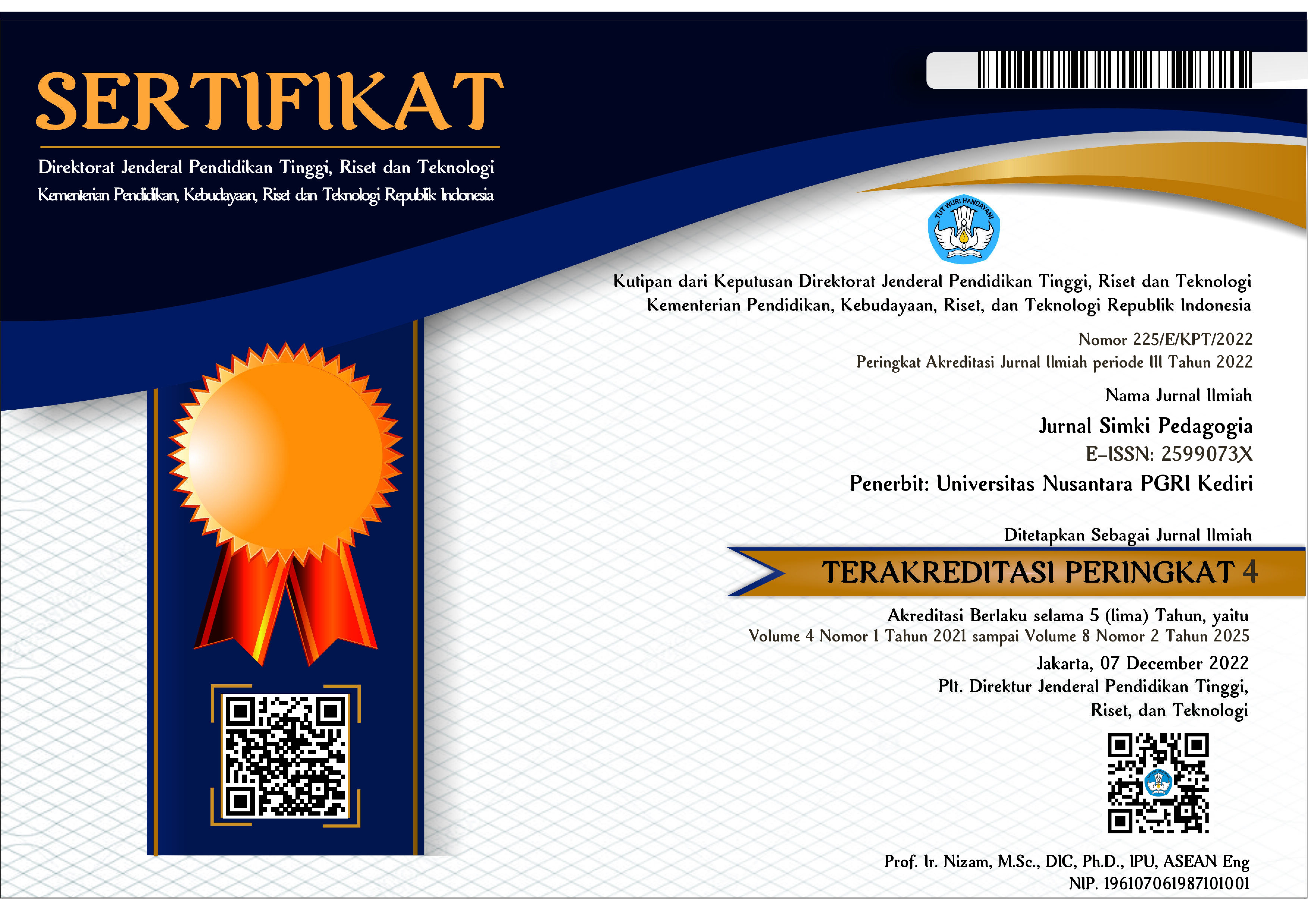Level Kemampuan Penalaran Spasial Siswa SMA dengan Gaya Belajar Kinestetik dalam Menyelesaikan Masalah Geometri
 Abstract views: 476
,
Abstract views: 476
,
 PDF (Bahasa Indonesia) downloads: 411
PDF (Bahasa Indonesia) downloads: 411
Abstract
This study aims to describe the level of spatial reasoning ability of high school students with a kinesthetic learning style in solving geometric problems. The subjects used in this study consisted of 2 students of class XII SMA Negeri 1 Kedamean Gresik. This research is a qualitative descriptive study. Data collection techniques in this research are spatial reasoning ability tests and interviews. Data analysis used in this study is data reduction, data presentation, and drawing conclusions. Researchers also used data analysis techniques from Milles & Huberman's research, namely data reduction, data presentation and drawing conclusions. Meanwhile, to check the validity of a data researcher uses source triangulation. The results showed that the subjects described the design model by looking at it as a real object, such as describing the problem as a robot composed of several cubes to form a robot and the image also resembles a water spray in the garden which is composed of several cubes and also the holes for the outlet. water. So that the subject is able to convert a two-dimensional icon into a three-dimensional one. The subject explained that the picture has 7 cubes, one of which is blocked by the previous cube and each cube has a hole. Whereas 1 large cube in the middle has 7 holes, so that the subject is able to make the correct relationship between two-dimensional icons and three-dimensional objects. The subject solves the problem by finding the volume of the cube first, that is, each cube has 27 unit cubes and is multiplied by the number of cubes and the result is subtracted by the number of holes in the cube. The subject is able to solve geometry problems correctly along with the steps and explanations. Thus the kinesthetic subject's spatial reasoning in solving geometric problems is included in the category of high-level spatial reasoning (spatial).
Downloads
References
Aini, N., & Suryowati, E. (2022). Mengeksplor Penalaran Spasial Siswa dalam Menyelesaikan Soal Geometri Berdasarkan Gender. Mosharafa: Jurnal Pendidikan Matematika, 11(1), 61–72. https://doi.org/10.31980/mosharafa.v11i1.1183
Anggraini, M. N. E., & Azmy, B. (2022). Pengaruh Model Pembelajaran Self Regulated Learning Terhadap Kemampuan Berpikir Kreatif Siswa Kelas V di SDN Tenggilis Mejoyo 1 Surabaya. MENDIDIK: Jurnal Kajian Pendidikan Dan Pengajaran, 8(1), 122-127.
Akbar, K. (2019). Kemampuan Penalaran Spasial Siswa Smpn 2 Praya Barat Daya. Media Pendidikan Matematika, 7(2), 17. https://doi.org/10.33394/mpm.v7i2.2094
Akbar, K. (2021). Eksplorasi Penelaran Spasial pada Konstruk Rotasi Mental dengan Media Google SketchUp. Jurnal Didaktika Pendidikan Dasar, 5(1), 143–164. https://doi.org/10.26811/didaktika.v5i1.203
Deporter & Hernacki. (2013). Quantum learning. Bandung: Kaifa.
Kurnia Putri, D., Sulianto, J., & Azizah, M. (2019). Kemampuan Penalaran Matematis Ditinjau dari Kemampuan Pemecahan Masalah. International Journal of Elementary Education, 3(3), 351. https://doi.org/10.23887/ijee.v3i3.19497
Latifah, N. (2019). MATHE dunesa. 8(3), 589–594.
Leni, N., Musdi, E., Arnawa, I. M., & Yerizon, Y. (2021). Profil Kemampuan Penalaran Spasial Siswa SMPN 1 Padangpanjang Pada Masalah Geometri. JIPM (Jurnal Ilmiah Pendidikan Matematika), 10(1), 111. https://doi.org/10.25273/jipm.v10i1.10000
Mabruroh, L. H., & Irianto, A. (2020). Pengaruh Metode Picture and Picture terhadap berpikir kreatif siswa sekolah dasar. Jurnal Pendidikan Dasar, 11(1), 102-108.
Maryono, Dwijayanti, I., & Sumarno. (2021). Analisis Kebutuhan Awal Pengembangan Media Pembelajaran Untuk Meningkatkan Motivasi dan Hasil Belajar Matematika Kelas V SD. Jurnal Widya Sari Press, 23, 111–120.
Miladiah, A., Ikhsan Karimah, N., & Pendidikan Matematika Universitas Swadaya Gunung Jati, P. (2020). Analisis Kemampuan Representasi Matematis Siswa dalam Menyelesaikan Soal Cerita Program Linear. Jurnal Riset Pembelajaran Matematika Sekolah, 4(1), 9–14.
Ningsih, I. P., Budiarto, M. T., & Khabibah, S. (2021). Literasi Spasial Siswa Smp Dalam Menyelesaikan Soal Geometri Ditinjau Dari Perbedaan Gaya Belajar. AKSIOMA: Jurnal Program Studi Pendidikan Matematika, 10(3), 1531. https://doi.org/10.24127/ajpm.v10i3.3650
Rahmadani. 2021. “Pengaruh Gaya Belajar Visual Terhadap Hasil Belajar Peserta Didik Pada Mata Pelajaran Ekonomi Dikelas X SMA Muhamadiyah 1 Metro Tahun Pelajaran 2020/2021.” Universitas Muhammadiyah Metro (Skripsi (S1) thesis.).
Syah, Z. (2022). Level penalaran spasial siswa MTs Negeri 1 Kota Malang dalam menyelesaikan soal bangun ruang. 187.
Tian, Z., & Huang, X. (2009). A study of children’s spatial reasoning and quantitative reasoning abilities. Journal of Mathematics Education, 2(2), 80–93.
Copyright (c) 2023 Moh. Syukron Maftuh, Ashfa Wildatun Ni’mah

This work is licensed under a Creative Commons Attribution 4.0 International License.

Jurnal Simki Pedagogia : https://jiped.org/index.php/JSP/index is licensed under a Creative Commons Attribution 4.0 International License.
















